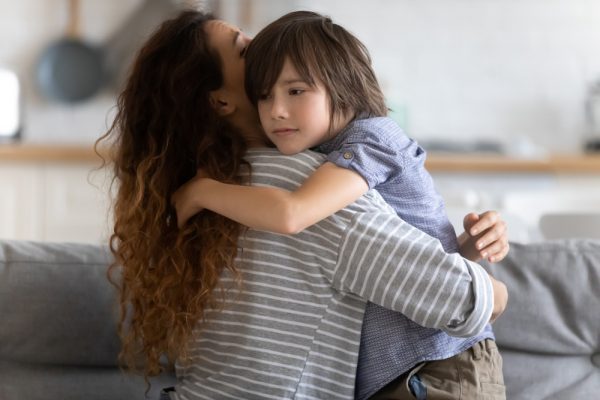
Many parents wonder how to raise kids who have a positive body image. Adults may be used to hearing a barrage of messages about childhood obesity rates and unhealthy habits. At the same time, the body positivity movement is growing, with everyone from Instagram influencers to major clothing brands making an effort to share images of more diverse body types. Add in a global pandemic that is nearing the 1-year mark in the United States, altering families’ physical activity and eating patterns, and you have the perfect recipe for parental confusion about how to handle topics like weight.
To get to the bottom of the body image question, we talked to Stephanie Harshman, PhD, RD, LD and clinical dietitian at MassGeneral Hospital for Children. Here’s what Dr. Harshman had to say about building positive body image in kids.
 Parents are Body Image Role Models
Parents are Body Image Role Models
Dr. Harshman says the number one thing she wants families to understand about building and maintaining a positive body image is that parents are role models. “How you talk about your body and eating habits will be reflected in your children and adolescents,” she says. “When we start to talk about our bodies or our weight at home, there are tools we can use to speak about it in neutral terms so that your child feels like they’re in an emotionally secure and safe space — that there’s no shaming or guilt involved.”
Some of the techniques Dr. Harshman recommends to help parents maintain neutral language around food and weight include:
- Share the purpose of food, not a value judgment. In other words, adults can share with kids that food provides fuel for our bodies. “I like to use the analogy of a sports car,” Dr. Harshman says. “Our bodies are like a fancy sports car, with a very important engine — our heart and our organs. The choices we make fuel our engine.” She recommends talking with kids about the great things foods can do for their bodies, such as helping them grow, strengthening their bones, or giving their brains energy to learn. That kind of discussion can take the focus off of judging foods as “good” or “bad” and worrying about their impact on weight.
- Focus on hunger cues, not food choices. Many adults worry about whether kids are overeating, especially around snack times. That concern can lead to restricting “snack foods,” which Dr. Harshman cautions just adds to the appeal of items like chips and sweets. Kids are likely to fixate more strongly on foods if adults restrict access to them, use them as rewards for eating “healthy” choices, or ban them altogether.
Instead, Dr. Harshman says, families can take the approach that all foods are fine as long as we pay attention to our hunger. “The conversation isn’t about labeling foods as healthy or unhealthy, it’s about bringing kids back into being more mindful about hunger cues,” she says. She adds that often snacking behavior in kids (and adults) is more about boredom or habit than hunger. Dr. Harshman encourages parents to talk to kids about the signals their bodies give them when they’re truly hungry, and to only eat when hunger strikes. “We have to listen to our body and tune in — when I notice these signs, that means I’m really hungry. That allows us to best regulate our eating patterns, no matter what our food choices are.” - Talk about what bodies can do, not what they look like. Dr. Harshman cautions that while well-meaning adults often think that a focus on weight is about measuring health, “weight is only one way to look at the health of our bodies.” She says that it’s important for families to talk about the function of our bodies, not how big or small they are. For example, adults might say “Our size might be different from our friends, and that’s okay. But does it stop us from doing what we want to do? Does it stop us from playing piano, or playing the sports we enjoy, or taking walks with the family? We should be proud and happy that our body allows us to do these things.”
Families can also take this idea one step further by finding ways to be active together. Dr. Harshman recommends building in family walks or bike rides after dinner, dance parties or any other group activity that will be fun for everyone. That shared activity can help send the message that it’s better to focus on how our bodies function than how they look. (Plus, exercising together is fun and good for us!)

Changing our Language Can Help
When conversations about weight and body image come up, Dr. Harshman says she hopes parents can understand that it’s okay for those discussions to be uncomfortable. Part of that discomfort comes from the cultural messaging that surrounds us, and the way most adults have been brought up to think about words like “fat” or “weight.” “The word ‘fat’ gets a bad rap,” Dr. Harshman says. Here are some of her suggestions to help families change their language to have more neutral, productive conversations about body image:
- Talk about fat as a noun, not an adjective. “Most children and adolescents don’t understand what the role of fat is,” Dr. Harshman says. “Talk about fat from a physiological sense — fat is important!” Parents can start by talking not about “being fat” or “looking fat,” but by explaining that we all have fat on our bodies. “It’s actually very important to have fat,” Dr. Harshman points out. “It allows us to store energy so our bodies always have fuel. It’s important for our muscles, so they can flex and run, and for our brains to continue to work throughout the day in between our meals.” Helping kids understand that fat is a necessary part of our diets and our bodies, not a way to describe ourselves, can take some of the negativity away from the word “fat.”
- Point out that body image is relative. Dr. Harshman encourages families to recognize that what we think about body shape and size often depends on cultural and social factors. “Different individuals, different cultures, different families all have different perspectives on what a body might look like and how we define our health and well-being,” she says. “You have to say that to kids over and over again.” She notes that even the “objective” measures we’re used to using to evaluate our bodies, like growth charts and BMI measurements, can be misleading or even harmful to developing a healthy body image. “Weight is only one way that we measure our health. It’s only one way to look at our bodies. There’s also our blood pressure, how we sleep, how active we are, so many other things.” Dr. Harshman recommends that parents help kids understand that bodies naturally fluctuate over time. She also notes that it’s okay to advocate for kids by requesting that health care providers not talk about or share the growth chart or BMI measurements during appointments.
- Normalize Body Changes. As kids grow, many of them will go through periods of intense change in their bodies — including rapid weight gain or sudden changes in shape. Dr. Harshman says kids’ concern over these changes often shows up as worrying about having to get a different clothing size, or not being happy about the way favorite clothes fit. Parents can help kids move through these inevitable changes by keeping language neutral and supportive. Rather than saying “You got bigger,” or “Your clothes are too small,” adults can try saying “Naturally, as we grow, we are going to fit in our clothes differently. We can go out and find some clothes that work for you and make you feel good.”
If kids are expressing concern about their bodies, parents can also help guide the conversation by letting the child lead the way. Dr. Harshman recommends asking “How do you feel about the changes your body has experienced?” and encouraging kids to come up with words and language they feel comfortable using to talk about their bodies.
 Family Meals Help us Keep Track of Kids’ Body Image
Family Meals Help us Keep Track of Kids’ Body Image
“Family meals are so important because they give you that short window into how your child eats at that period during the day,” Dr. Harshman says, adding that dinner together (or any other meal) provides a good opportunity to open up a dialogue about eating and body image. However, dinner conversations about food and weight-related ideas should be kept neutral and welcoming. If a deeper or more personal conversation is needed, it’s usually best to find another time to speak to the child one on one so they can open up in a more private setting.
It’s also important for adults to recognize when a child’s behavior signals a bigger issue that might require professional help. Parents might notice these warning signs that a child is struggling with body image:
- Their portion sizes are getting smaller. We all vary our intake of food from day to day depending on our hunger, but Dr. Harshman notes that regular family meals allow us to see patterns in portion size. If a child is consistently reducing portion sizes over time, it may be an indication that they’re struggling with body image. Parents can take this behavior as a signal to check in, but Dr. Harshman cautions that it’s best not to bring up how much they are or are not eating. Rather than “I see you haven’t been eating a lot,” she says adults might try a more neutral approach: “A portion size of blueberries is about this much. Is it okay if next time I give you this much, or do you prefer to have the smaller amount on your plate?”
- They’re avoiding family meals or changing their eating patterns. When kids are worried about their weight or body shape, they might start to make excuses to stay away from family mealtimes. “If you notice that children say they’re too busy to engage in a family meal and they’d rather eat later or alone, that’s something to look out for.” Dr. Harshman also points out that some older kids will try to eat alone at odd hours, such as going into the kitchen later at night “after the kitchen’s typically closed in that household.” If parents are noticing these behaviors, or more severe behavior changes like obsessively checking weight or secretly over-exercising, Dr. Harshman says it may be time to check in with the child’s doctor or with a mental health professional.

It’s Never too Late to Change the Way We Talk About Bodies
If you’re reading this article and thinking “I’ve made some mistakes in handling body image issues with my kids,” you’re not alone. Weight and body size are tricky topics for many of us. It’s common for well-meaning adults to say and do things that they believe will help build healthy habits, but are actually harmful to kids’ body image. The good news is, it’s not too late to change course. Dr. Harshman acknowledges that it’s hard and upsetting to recognize that you need to change your language and habits, but encourages adults to be honest and put forth their best efforts to do better.
- Start finding new ways to talk about old concepts. For example, if you used to talk about how much you needed to exercise to lose weight, Dr. Harshman says you can change that language now. Try saying “It would be a great idea for us to walk together!” and get rid of the focus on weight and body image completely. If a child asks why you want to take a walk, practice sharing other benefits of exercise, like “It’s good for our muscles” or “It would be nice to step away from screens for a while and get some fresh air.”
- Help kids change their language while you change yours. If you’ve been in the habit of using words like “fat,” or labeling foods as “bad” or “cheat” foods, it’s time to stop — and to help kids stop as well. Dr. Harshman suggests that parents can be direct and honest about why the change is needed. “You’re right — we used to say that, but actually, I learned that foods aren’t ‘bad’ or ‘good.’ Some might have different nutrients that we should have more often than others, but there’s no such thing as a ‘bad food.’”
- Be honest about your own struggles. If you’ve spoken negatively about bodies in the past — such as talking about the way someone looks in a swimsuit, or focusing on your child’s weight or clothing size — it’s time for a change. Kids, especially older children, might have questions about why you’re suddenly making a switch. Dr. Harshman encourages adults to share openly so they can move forward with more positive interactions in the future. “I speak that way because I also don’t speak to myself kindly either,” might be a way to share how our own problems with self-image impact how we talk to others. Or parents might initiate a discussion this way: “I wanted to talk about this, because actually what we’ve been doing hasn’t been good for us or you. I wanted to think about how we can move forward and engage in a different way.”
The bottom line is that building positive body image in kids — or in ourselves — can be difficult. But Dr. Harshman’s advice shows that all families can start by adopting a weight-neutral, accepting household culture. With regular family mealtimes, consistent habits around eating and exercise, and a shared focus on loving our bodies for what they can do rather than how they look, we can help kids develop a healthy body image. And helping kids grow to feel confident about their bodies might help adults move past some of their own insecurities, too. In the end, changing the way we think and speak about food and weight could be good for us all.
